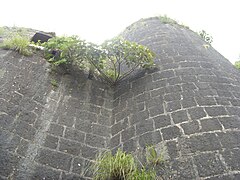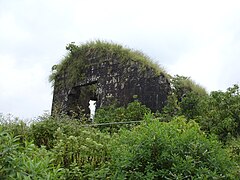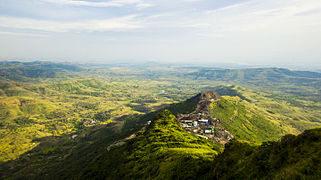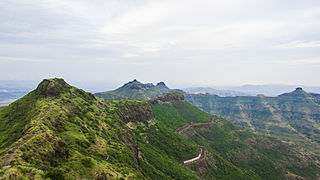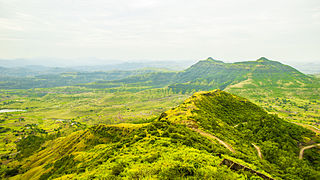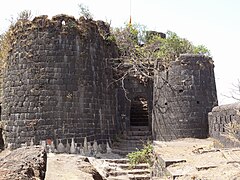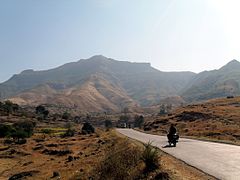Purandar Fort
| Purandar Fort | |
|---|---|
| Pune district,Maharashtra | |
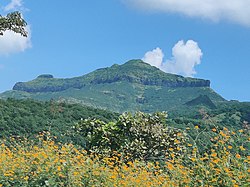 Purandhar Fort | |
| Coordinates | 18°16′50.8″N73°58′25″E/ 18.280778°N 73.97361°E |
| Type | Hill fort |
| Height | 1,374 metres (4,508 ft) |
| Site information | |
| Owner | Government of India |
| Open to the public | Yes |
| Condition | Ruins |
| Site history | |
| Materials | Stone |
Purandar Fortis a mountain fort inPune districtinWestern Indianstate ofMaharashtra,India. The fort stands at 1,374 metres (4,508 ft) above the sea level in theWestern Ghats,50 kilometres (31 mi) to the southeast ofPune.[1]
The twin forts of Purandar and Vajragad (or Rudramal) of which the latter is the smaller of the two, is located on the eastern side of the main fort rising 1,347 metres (4,419 ft) above sea level.[1]The village ofPurandartakes its name from this fort.[2]It is the birthplace of Dharmaveer ChatrapatiSambhaji Maharaj.[3]
History[edit]
The oldest known reference of existence of the Purandar fort dates back to theYadava dynastyin the 11th century.[citation needed]
After the defeat of the Yadavas by the foreign invaders,[citation needed]the territory surrounding the fort fell into the hands of the invaders who further fortified the Purandar Fort in 1350 A.D. During the early rule of theBijapurandAhmednagarkings, The Purandar Fort was among the forts directly under the Government rule and was never entrusted toJagirdars.[4]
Under the rule of theBerar Sultanate,the fort was besieged several times. To prevent the Purandar Fort from ever falling again, a sacrificial ritual was performed where a man and a woman were buried alive under one of the fort bastions to appease its patron deity.[5]Another ritual was soon performed where the king ordered a minister to bury a first-born son and his mother into the foundation of the bastion which was promptly done with a further offering of gold and bricks. When the bastion was finished, The minister, Yesaji Naik, was given possession of the Purandar Fort and the father of the sacrificed boy was rewarded with two villages.[6]
To protest Adilshahi commander Fatehkhan In 1649 Chhatrapati Shivaji Maharaj took the charge of fort temporarly from Raje Mahadaji Neelkanthrao Sarnaik who was his father's friend and commander of Purandar for 4 generations. On the occasion of Diwali in 1656 after 2 years of death of Mahadajipant Chhatrapati Shivaji Maharaj took advantage of family disputes in Mahadajipant's 4 sons Neelkanth, Shankar, Tryambak/Pilaji and Vishwanath/Visaji and captured the fort.[7]In 1596 A.D, theBahudar Shahof theAhmadnagar Sultanategranted the territory of "Pune" and "Supa" toMaloji Bhosale,the grandfather of Shivaji.[citation needed]The Purandar Fort was included in the territory.

In 1646 A.D, Shivaji, still in his youth, in one of his first victories for theMaratha Empire,raided and established control of the fort. In 1665 A.D, the Purandar Fort was besieged by the forces ofAurangzeb,under the command ofJai Singh IIand assisted byDiler Khan.Murarbaji Deshpandeof Mahr, who was appointed as thekilledar(keeper of the fort), offered strong resistance against the Mughal forces ultimately giving up his life in a struggle to retain the fort. Shivaji, daunted at the prospect of the fall of his grandfather's fort, signed a treaty known as theFirst Treaty of PurandarwithAurangzebin 1665. According to the treaty, Shivaji handed over twenty-three forts including Purandar, and a territory with a revenue of four lakhhonsand was made thejagirdarof the territory.
In 1670 A.D, the truce did not last long as Shivaji revolted against Aurangzeb and recaptured Purandar after just five years.
Under thePeshwarule, the Purandar Fort acted as a stronghold whenever their capital city ofPunewas under attack. In 1776 A.D, a treaty was signed between theBritish Rajand theMaratha Statesknown as theSecond Treaty of Purandar.Its conditions were never fulfilled, being overruled by the subsequentTreaty of Salbaiin 1782 between theBombay GovernmentandRaghunathrao,at the close of theFirst Anglo-Maratha War.[4]
In 1790, it was conquered by aKolichiefKuroji Naikand a Victory Bastion also erected here.[8][9][10]
In 1818, the Purandar Fort was invaded by aBritishforce under General Pritzler. On 14 March 1818, a British garrison marched into Vajragad (the smaller fort). As Vajragad commanded Purandar, the commandant had to accept terms and the British flag was hoisted at Purandar on 16 March 1818. During theBritish Raj,the fort was used as a prison. During World War II, it was an internment camp for enemy-alien (i.e.German) families. Jews from Germany were interned. A German prisoner,Dr. H. Goetzwas held here duringWorld War II.He studied the fort during his stay and later published a book on it. The fort's major use however, was as asanatoriumfor the British soldiers.[3]
The thousand-year-oldNarayaneshwartemple[citation needed]of theHemadpanthi architecturebuilt by theYadavasstill exists at the base village of the fort calledNarayanpur.

It is believed that Purandar is the broken part of theDronagiri Parvat,whichHanumancarried in theRamayana.[4]
Structures[edit]

The fort has two distinct levels. The lower part of Purandar is called themachi.North of the machi is a flat area where the cantonment and hospital was housed.
There are many temples dedicated to Purandareshwar (the fort's patron god, from which it also takes its name) and Sawai Madhavrao Peshwa here. There is a statue ofMurarbaji Deshpande,the commander (killedar) of the fort who gave up his life in order to protect the fort from theMughals.The northern part of themachihas a low fall with several bastions and an imposing gate with two towers.[4]

From the lower level of themachi,a staircase leads to the upper level calledBallekilla.The first structure of theBallekillathat comes into view is theDilli Darwaja(Delhi Gate). This area also houses an ancient Kedareshwar (Shiva) temple. TheBALLEKILLAis also surrounded by steep drop on three sides.
Current use[edit]
The Purandar Fort is a popular tourist destination and is also used by theNational Cadet Corpsacademy for training purposes. The fort is a hotspot forparaglidersandtrekkers.[3][additional citation(s) needed]
Gallery of Purandar Fort[edit]
See also[edit]
References[edit]
- ^abSurvey of India - Scale 1:50K Map sheet number 47F/15
- ^This monsoon visit Purandar fort
- ^abcMaharashtra state tourism site
- ^abcdHunter, William (1886),The Imperial Gazetteer of India,London: Trubner and Co.,retrieved18 January2009
- ^Sholapur District Gazetteer
- ^Toy, Sidney (1965).The Fortified Cities of India.London: Heinemann Educational Books Ltd. p.51.
- ^https://archive.org/details/in.ernet.dli.2015.495002/page/n10/mode/1up
- ^Gazetteer of the Bombay Presidency: Poona (2 pts.).Government Central Press. 1885.
- ^"Maharashtra Gazetteers".
- ^Transactions of the Medical and Physical Society of Bombay.1862.




